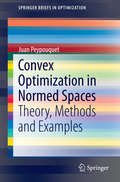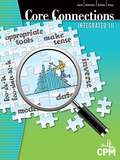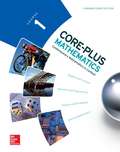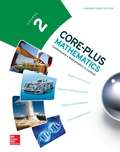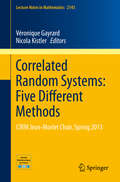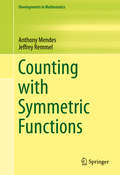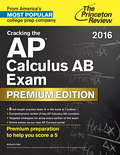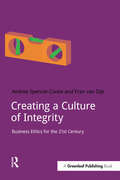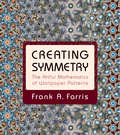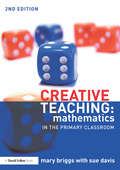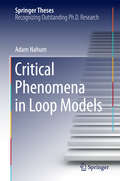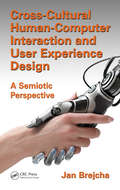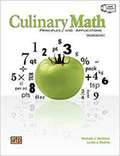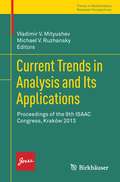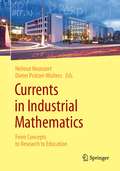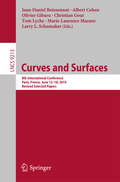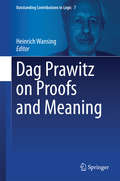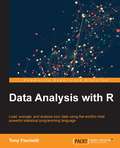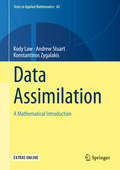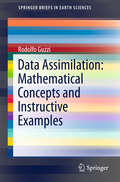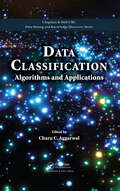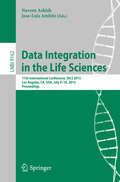- Table View
- List View
Convex Optimization in Normed Spaces: Theory, Methods and Examples (SpringerBriefs in Optimization #0)
by Juan PeypouquetThis work is intended to serve as a guide for graduate students and researchers who wish to get acquainted with the main theoretical and practical tools for the numerical minimization of convex functions on Hilbert spaces. Therefore, it contains the main tools that are necessary to conduct independent research on the topic. It is also a concise, easy-to-follow and self-contained textbook, which may be useful for any researcher working on related fields, as well as teachers giving graduate-level courses on the topic. It will contain a thorough revision of the extant literature including both classical and state-of-the-art references.
Convex Optimization of Power Systems
by Joshua Adam TaylorOptimization is ubiquitous in power system engineering. Drawing on powerful, modern tools from convex optimization, this rigorous exposition introduces essential techniques for formulating linear, second-order cone, and semidefinite programming approximations to the canonical optimal power flow problem, which lies at the heart of many different power system optimizations. Convex models in each optimization class are then developed in parallel for a variety of practical applications like unit commitment, generation and transmission planning, and nodal pricing. Presenting classical approximations and modern convex relaxations side-by-side, and a selection of problems and worked examples, this is an invaluable resource for students and researchers from industry and academia in power systems, optimization, and control.
Core Connections Integrated II
by Leslie DietikerCore Connections Integrated II Core Connections Integrated II is the second course in a five-year sequence of college preparatory mathematics courses that starts with Core Connections Integrated I and continues through Calculus Third Edition. It aims to formalize and extend the geometry that students have learned in previous courses. It does this by focusing on establishing triangle congruence criteria using rigid motions and formal constructions and building a formal understanding of similarity based on dilations and proportional reasoning. It also helps students develop the concepts of formal proof, explore the properties of two- and three-dimensional objects, work within the rectangular coordinate system to verify geometric relationships and prove basic theorems about circles. Students also use the language of set theory to compute and interpret probabilities for compound events. On a daily basis, students in Core Connections Integrated II use problem-solving strategies, questioning, investigating, analyzing critically, gathering and constructing evidence, and communicating rigorous arguments justifying their thinking. Under teacher guidance, students learn in collaboration with others while sharing information, expertise, and ideas.
Core Connections Integrated III, Version 5.0
by Judy Kysh Karen Wootton Michael KassarjianNIMAC-sourced textbook
Core-Plus Mathematics: Contemporary Mathematics in Context, Course 1
by Christian R. Hirsch James T. Fey Eric W. HartContemporary Mathematics in Context engages students in investigation-based, multi-day lessons organized around big ideas. Important mathematical concepts are developed in relevant contexts by students in ways that make sense to them. Courses 1, along with Courses 2 and 3, comprise a core curriculum that upgrades the mathematics experience for all your students. Course 4 is designed for all college-bound students. Developed with funding from the National Science Foundation, each course is the product of a four-year research, development, and evaluation process involving thousands of students in schools across the country.
Core Plus Mathematics, Course 2, Student Edition (Elc: Core Plus Ser.)
by Hirsch2015 McGraw-HillA mathematics textbook.
Correlated Random Systems: CIRM Jean-MorletChair, Spring 2013 (Lecture Notes in Mathematics #2143)
by Véronique Gayrard Nicola KistlerThis volume presents five different methods recently developed to tackle the large scale behavior of highly correlated random systems, such as spin glasses, random polymers, local times and loop soups and random matrices. These methods, presented in a series of lectures delivered within the Jean-Morlet initiative (Spring 2013), play a fundamental role in the current development of probability theory and statistical mechanics. The lectures were: Random Polymers by E. Bolthausen, Spontaneous Replica Symmetry Breaking and Interpolation Methods by F. Guerra, Derrida's Random Energy Models by N. Kistler, Isomorphism Theorems by J. Rosen and Spectral Properties of Wigner Matrices by B. Schlein. This book is the first in a co-edition between the Jean-Morlet Chair at CIRM and the Springer Lecture Notes in Mathematics which aims to collect together courses and lectures on cutting-edge subjects given during the term of the Jean-Morlet Chair, as well as new material produced in its wake. It is targeted at researchers, in particular PhD students and postdocs, working in probability theory and statistical physics.
Counting with Symmetric Functions (Developments in Mathematics #43)
by Anthony Mendes Jeffrey RemmelThis monograph provides a self-contained introduction to symmetric functions and their use in enumerative combinatorics. It is the first book to explore many of the methods and results that the authors present. Numerous exercises are included throughout, along with full solutions, to illustrate concepts and also highlight many interesting mathematical ideas. The text begins by introducing fundamental combinatorial objects such as permutations and integer partitions, as well as generating functions. Symmetric functions are considered in the next chapter, with a unique emphasis on the combinatorics of the transition matrices between bases of symmetric functions. Chapter 3 uses this introductory material to describe how to find an assortment of generating functions for permutation statistics, and then these techniques are extended to find generating functions for a variety of objects in Chapter 4. The next two chapters present the Robinson-Schensted-Knuth algorithm and a method for proving Pólya's enumeration theorem using symmetric functions. Chapters 7 and 8 are more specialized than the preceding ones, covering consecutive pattern matches in permutations, words, cycles, and alternating permutations and introducing the reciprocity method as a way to define ring homomorphisms with desirable properties. Counting with Symmetric Functions will appeal to graduate students and researchers in mathematics or related subjects who are interested in counting methods, generating functions, or symmetric functions. The unique approach taken and results and exercises explored by the authors make it an important contribution to the mathematical literature.
Cox Rings
by Ivan Arzhantsev Ulrich Derenthal Jürgen Hausen Antonio LafaceCox rings are significant global invariants of algebraic varieties, naturally generalizing homogeneous coordinate rings of projective spaces. This book provides a largely self-contained introduction to Cox rings, with a particular focus on concrete aspects of the theory. Besides the rigorous presentation of the basic concepts, other central topics include the case of finitely generated Cox rings and its relation to toric geometry; various classes of varieties with group actions; the surface case; and applications in arithmetic problems, in particular Manin's conjecture. The introductory chapters require only basic knowledge in algebraic geometry. The more advanced chapters also touch on algebraic groups, surface theory, and arithmetic geometry. Each chapter ends with exercises and problems. These comprise mini-tutorials and examples complementing the text, guided exercises for topics not discussed in the text, and, finally, several open problems of varying difficulty.
Cracking the AP Calculus AB Exam 2016, Premium Edition
by Princeton ReviewPREMIUM PRACTICE FOR A PERFECT 5! Equip yourself to ace the AP Calculus AB Exam with this Premium version of The Princeton Review's comprehensive study guide. In addition to thorough content reviews, targeted test strategies, and access to AP Connect extras via our online portal, this title includes 6 full-length practice tests (the highest number in the market!) with complete answer explanations!This eBook edition has been specially formatted for on-screen viewing with cross-linked questions, answers, and explanations.Everything You Need to Know to Help Achieve a High Score.* Comprehensive content review for all test topics* Up-to-date information on the 2016 AP Calculus AB Exam* Engaging activities to help you critically assess your progress* Access to AP Connect, our online portal for helpful pre-college information and exam updatesPremium Practice to Help Achieve Excellence.* 6 full-length practice tests with detailed answer explanations* Practice drills throughout each content review chapter* Handy reference guide of key calculus formulasTechniques That Actually Work.* Tried-and-true strategies to help you avoid traps and beat the test* Tips for pacing yourself and guessing logically* Essential tactics to help you work smarter, not harderWe don't have to tell you how tough AP Calculus can be to master--but with Cracking the AP Calculus AB Exam 2016, Premium Edition, you'll be armed to take on the test and achieve your highest possible score!
Creating a Culture of Integrity: Business Ethics for the 21st Century (Doshorts Ser.)
by Andrea Spencer-Cooke Fran van DijkFor companies, unethical business practices like bribery and corruption pose major business risks, and can result in fines, reputational damage, lost business opportunity and – increasingly – criminal or civil charges.Organizations have responded to this critical governance issue with rigorous formal integrity and compliance frameworks, to set out and enforce standards for ethical business practice. But companies also need to create an enduring culture of integrity that establishes doing the right thing as the cultural norm across the organization – and this requires more than compliance alone.Creating a Culture of Integrity identifies the key actions sustainability and compliance officers can take to foster this cultural shift within their organizations.This "one-stop" toolkit for embedding integrity also includes: inspiring best-practice case studies from companies who’ve implemented culture change, with insights on how they deal with ethical dilemmas when these arise and; powerful arguments to help you make the business case for building a strong ethical culture around your compliance system.
Creating Symmetry
by Frank A. FarrisThis lavishly illustrated book provides a hands-on, step-by-step introduction to the intriguing mathematics of symmetry. Instead of breaking up patterns into blocks--a sort of potato-stamp method--Frank Farris offers a completely new waveform approach that enables you to create an endless variety of rosettes, friezes, and wallpaper patterns: dazzling art images where the beauty of nature meets the precision of mathematics.Featuring more than 100 stunning color illustrations and requiring only a modest background in math, Creating Symmetry begins by addressing the enigma of a simple curve, whose curious symmetry seems unexplained by its formula. Farris describes how complex numbers unlock the mystery, and how they lead to the next steps on an engaging path to constructing waveforms. He explains how to devise waveforms for each of the 17 possible wallpaper types, and then guides you through a host of other fascinating topics in symmetry, such as color-reversing patterns, three-color patterns, polyhedral symmetry, and hyperbolic symmetry. Along the way, Farris demonstrates how to marry waveforms with photographic images to construct beautiful symmetry patterns as he gradually familiarizes you with more advanced mathematics, including group theory, functional analysis, and partial differential equations. As you progress through the book, you'll learn how to create breathtaking art images of your own.Fun, accessible, and challenging, Creating Symmetry features numerous examples and exercises throughout, as well as engaging discussions of the history behind the mathematics presented in the book.
Creative Teaching: Mathematics in the Primary Classroom
by Mary Briggs Sue DavisThis stimulating text shows how primary mathematics can be creative, exciting and enjoyable. Offering teachers a dynamic and different perspective, it enables them to see and teach in creative ways that will develop their pupil’s mathematical thinking potential. Creative Teaching: Mathematics in the Primary Classroom encourages students, trainees and practicing teachers to envision and develop a classroom where children can take risks, enjoy and experiment with mathematical thinking, and discover and pursue their interests and talents in an imaginative yet purposeful way. This second edition contains key updates to reflect the changes to the primary curriculum and includes: new sections on: specialist teaching, parental engagement and approaches to homework; creative classroom environments; working walls, displays and outdoor settings; links to assessment, speaking, listening and learning theory; use of media, film, news and stories for creative learning; cross-curricula work. Featuring reflective tasks in every chapter, this book will prove essential and inspiring reading for all trainee and practising teachers looking to develop their creative practice. Aimed at primary and early years trainee teachers, NQTs and experienced teachers, this is a timely publication for teachers and schools seeking to broaden their maths curriculum, making it more creative and appealing to young minds.
Critical Phenomena in Loop Models (Springer Theses)
by Adam NahumWhen close to a continuous phase transition, many physical systems can usefully be mapped to ensembles of fluctuating loops, which might represent for example polymer rings, or line defects in a lattice magnet, or worldlines of quantum particles. 'Loop models' provide a unifying geometric language for problems of this kind. This thesis aims to extend this language in two directions. The first part of the thesis tackles ensembles of loops in three dimensions, and relates them to the statistical properties of line defects in disordered media and to critical phenomena in two-dimensional quantum magnets. The second part concerns two-dimensional loop models that lie outside the standard paradigms: new types of critical point are found, and new results given for the universal properties of polymer collapse transitions in two dimensions. All of these problems are shown to be related to sigma models on complex or real projective space, CP^{{n−1}} or RP^{{n−1}} -- in some cases in a 'replica' limit -- and this thesis is also an in-depth investigation of critical behaviour in these field theories.
Cross-Cultural Human-Computer Interaction and User Experience Design: A Semiotic Perspective
by Jan BrejchaThis book describes patterns of language and culture in human-computer interaction (HCI). Through numerous examples, it shows why these patterns matter and how to exploit them to design a better user experience (UX) with computer systems. It provides scientific information on the theoretical and practical areas of the interaction and communication design for research experts and industry practitioners and covers the latest research in semiotics and cultural studies, bringing a set of tools and methods to benefit the process of designing with the cultural background in mind.
Culinary Math: Principles And Applications
by Michael J. Mcgreal Linda J. PadillaCulinary Math Principles and Applications" demonstrates how and why foodservice workers use math in the professional kitchen. This popular text-workbook helps learners grasp culinary math principles and applications through an engaging and well-illustrated style. Interactive learner resources provide opportunities for reinforcement and further examples of math used in culinary settings. This educational resource can serve as a basis for college culinary math, foodservice math, and hospitality math courses.
Current Trends in Analysis and Its Applications: Proceedings of the 9th ISAAC Congress, Kraków 2013 (Trends in Mathematics)
by Vladimir V. Mityushev Michael V. RuzhanskyThis book is a collection of papers from the 9th International ISAAC Congress held in 2013 in Kraków, Poland. The papers are devoted to recent results in mathematics, focused on analysis and a wide range of its applications. These include up-to-date findings of the following topics: - Differential Equations: Complex and Functional Analytic Methods - Nonlinear PDE - Qualitative Properties of Evolution Models - Differential and Difference Equations - Toeplitz Operators - Wavelet Theory - Topological and Geometrical Methods of Analysis - Queueing Theory and Performance Evaluation of Computer Networks - Clifford and Quaternion Analysis - Fixed Point Theory - M-Frame Constructions - Spaces of Differentiable Functions of Several Real Variables Generalized Functions - Analytic Methods in Complex Geometry - Topological and Geometrical Methods of Analysis - Integral Transforms and Reproducing Kernels - Didactical Approaches to Mathematical Thinking Their wide applications in biomathematics, mechanics, queueing models, scattering, geomechanics etc. are presented in a concise, but comprehensible way, such that further ramifications and future directions can be immediately seen.
Currents in Industrial Mathematics: From Concepts to Research to Education
by Helmut Neunzert Dieter Prätzel-WoltersThis book offers an insider's view of how industrial problems are translated into mathematics and how solving the mathematics leads to convincing industrial solutions as well. In 6 technical chapters, a wide range of industrial problems is modeled, simulated, and optimized; 4 others describe the modeling, computing, optimization, and data analysis concepts shaping the work of the Fraunhofer ITWM. Each technical chapter illustrates how the relevant mathematics has been adapted or extended for the specific application and details the underlying practical problem and resulting software. The final chapter shows how the use of mathematical modeling in the classroom can change the image of this subject, making it exciting and fun.
Curves and Surfaces: 8th International Conference, Paris, France, June 12-18, 2014, Revised Selected Papers (Lecture Notes in Computer Science #9213)
by Albert Cohen Tom Lyche Larry L. Schumaker Jean-Daniel Boissonnat Olivier Gibaru Christian Gout Marie-Laurence MazureThis volume constitutes the thoroughly refereed post-conference proceedings of the 8th International Conference on Curves and Surfaces, held in Paris, France, in June 2014. The conference had the overall theme: "Representation and Approximation of Curves and Surfaces and Applications". The 32 revised full papers presented were carefully reviewed and selected from 39 submissions. The scope of the conference was on following topics: approximation theory, computer-aided geometric design, computer graphics and visualization, computational geometry and topology, geometry processing, image and signal processing, interpolation and smoothing, mesh generation, finite elements and splines, scattered data processing and learning theory, sparse and high-dimensional approximation, subdivision, wavelets and multi-resolution method.
Dag Prawitz on Proofs and Meaning (Outstanding Contributions to Logic #7)
by Heinrich WansingThis volume is dedicated to Prof. Dag Prawitz and his outstanding contributions to philosophical and mathematical logic. Prawitz's eminent contributions to structural proof theory, or general proof theory, as he calls it, and inference-based meaning theories have been extremely influential in the development of modern proof theory and anti-realistic semantics. In particular, Prawitz is the main author on natural deduction in addition to Gerhard Gentzen, who defined natural deduction in his PhD thesis published in 1934. The book opens with an introductory paper that surveys Prawitz's numerous contributions to proof theory and proof-theoretic semantics and puts his work into a somewhat broader perspective, both historically and systematically. Chapters include either in-depth studies of certain aspects of Dag Prawitz's work or address open research problems that are concerned with core issues in structural proof theory and range from philosophical essays to papers of a mathematical nature. Investigations into the necessity of thought and the theory of grounds and computational justifications as well as an examination of Prawitz's conception of the validity of inferences in the light of three "dogmas of proof-theoretic semantics" are included. More formal papers deal with the constructive behaviour of fragments of classical logic and fragments of the modal logic S4 among other topics. In addition, there are chapters about inversion principles, normalization of p roofs, and the notion of proof-theoretic harmony and other areas of a more mathematical persuasion. Dag Prawitz also writes a chapter in which he explains his current views on the epistemic dimension of proofs and addresses the question why some inferences succeed in conferring evidence on their conclusions when applied to premises for which one already possesses evidence.
Data Analysis with R
by Tony FischettiLoad, wrangle, and analyze your data using the world's most powerful statistical programming language About This Book * Load, manipulate and analyze data from different sources * Gain a deeper understanding of fundamentals of applied statistics * A practical guide to performing data analysis in practice Who This Book Is For Whether you are learning data analysis for the first time, or you want to deepen the understanding you already have, this book will prove to an invaluable resource. If you are looking for a book to bring you all the way through the fundamentals to the application of advanced and effective analytics methodologies, and have some prior programming experience and a mathematical background, then this is for you. What You Will Learn * Navigate the R environment * Describe and visualize the behavior of data and relationships between data * Gain a thorough understanding of statistical reasoning and sampling * Employ hypothesis tests to draw inferences from your data * Learn Bayesian methods for estimating parameters * Perform regression to predict continuous variables * Apply powerful classification methods to predict categorical data * Handle missing data gracefully using multiple imputation * Identify and manage problematic data points * Employ parallelization and Rcpp to scale your analyses to larger data * Put best practices into effect to make your job easier and facilitate reproducibility In Detail Frequently the tool of choice for academics, R has spread deep into the private sector and can be found in the production pipelines at some of the most advanced and successful enterprises. The power and domain-specificity of R allows the user to express complex analytics easily, quickly, and succinctly. With over 7,000 user contributed packages, it's easy to find support for the latest and greatest algorithms and techniques. Starting with the basics of R and statistical reasoning, Data Analysis with R dives into advanced predictive analytics, showing how to apply those techniques to real-world data though with real-world examples. Packed with engaging problems and exercises, this book begins with a review of R and its syntax. From there, get to grips with the fundamentals of applied statistics and build on this knowledge to perform sophisticated and powerful analytics. Solve the difficulties relating to performing data analysis in practice and find solutions to working with "messy data", large data, communicating results, and facilitating reproducibility. This book is engineered to be an invaluable resource through many stages of anyone's career as a data analyst. Style and approach Learn data analysis using engaging examples and fun exercises, and with a gentle and friendly but comprehensive "learn-by-doing" approach.
Data Assimilation: A Mathematical Introduction (Texts in Applied Mathematics #62)
by Kody Law Andrew Stuart Konstantinos ZygalakisThis book provides a systematic treatment of the mathematical underpinnings of work in data assimilation, covering both theoretical and computational approaches. Specifically the authors develop a unified mathematical framework in which a Bayesian formulation of the problem provides the bedrock for the derivation, development and analysis of algorithms; the many examples used in the text, together with the algorithms which are introduced and discussed, are all illustrated by the MATLAB software detailed in the book and made freely available online. The book is organized into nine chapters: the first contains a brief introduction to the mathematical tools around which the material is organized; the next four are concerned with discrete time dynamical systems and discrete time data; the last four are concerned with continuous time dynamical systems and continuous time data and are organized analogously to the corresponding discrete time chapters. This book is aimed at mathematical researchers interested in a systematic development of this interdisciplinary field, and at researchers from the geosciences, and a variety of other scientific fields, who use tools from data assimilation to combine data with time-dependent models. The numerous examples and illustrations make understanding of the theoretical underpinnings of data assimilation accessible. Furthermore, the examples, exercises and MATLAB software, make the book suitable for students in applied mathematics, either through a lecture course, or through self-study.
Data Assimilation: Mathematical Concepts and Instructive Examples (SpringerBriefs in Earth Sciences)
by Rodolfo GuzziThis book endeavours to give a concise contribution to understanding the data assimilation and related methodologies. The mathematical concepts and related algorithms are fully presented, especially for those facing this theme for the first time. The first chapter gives a wide overview of the data assimilation steps starting from Gauss' first methods to the most recent as those developed under the Monte Carlo methods. The second chapter treats the representation of the physical system as an ontological basis of the problem. The third chapter deals with the classical Kalman filter, while the fourth chapter deals with the advanced methods based on recursive Bayesian Estimation. A special chapter, the fifth, deals with the possible applications, from the first Lorenz model, passing trough the biology and medicine up to planetary assimilation, mainly on Mars. This book serves both teachers and college students, and other interested parties providing the algorithms and formulas to manage the data assimilation everywhere a dynamic system is present.
Data Classification: Algorithms and Applications (Chapman And Hall/crc Data Mining And Knowledge Discovery Ser. #35)
by Charu C. AggarwalComprehensive Coverage of the Entire Area of ClassificationResearch on the problem of classification tends to be fragmented across such areas as pattern recognition, database, data mining, and machine learning. Addressing the work of these different communities in a unified way, Data Classification: Algorithms and Applications explores the underlyi
Data Integration in the Life Sciences: 11th International Conference, DILS 2015, Los Angeles, CA, USA, July 9-10, 2015, Proceedings (Lecture Notes in Computer Science #9162)
by Naveen Ashish Jose-Luis AmbiteThis book constitutes the proceedings of the 11th International Conference on Data Integration in the Life Sciences, DILS 2015, held in Los Angeles, CA, USA, in July 2015. The 24 papers presented in this volume were carefully reviewed and selected from 40 submissions. They are organized in topical sections named: data integration technologies; ontology and knowledge engineering for data integration; biomedical data standards and coding; medical research applications; and graduate student consortium.
